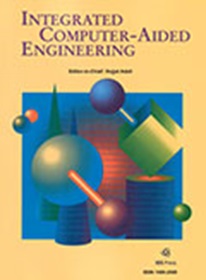一种基于脉冲序列时间信息的硬件高效皮质内神经解码方法
IF 5.3
2区 计算机科学
Q1 COMPUTER SCIENCE, ARTIFICIAL INTELLIGENCE
引用次数: 1
摘要
运动意图解码是脑机接口(BMI)中最具挑战性的问题之一。尽管对精确算法进行了几项重要的研究,但解码阶段仍然在计算机上进行处理,这使得该解决方案由于其尺寸和功耗而不适合植入式应用。本研究提出了一种具有新的输入模型和高效硬件的敏捷解码算法,旨在为植入式bmi提供一种合适的实时解码方法。该方法采用了一种基于脉冲序列时间信息的新输入空间,不同于一般的脉冲频率输入方法。基于两只雄性恒河猴以8个角度作为输出空间的正面视场(FEF)真实数据集对该方法进行了评估,解码准确率为62%。在此基础上,设计了用于实时神经解码的专用集成电路(ASIC)硬件架构。设计的芯片采用标准互补金属氧化物半导体(CMOS) 180 nm工艺实现,占地面积4.15 mm2,功耗28.58 μW @1.8 V。本文章由计算机程序翻译,如有差异,请以英文原文为准。
A hardware efficient intra-cortical neural decoding approach based on spike train temporal information
Motor intention decoding is one of the most challenging issues in brain machine interface (BMI). Despite several important studies on accurate algorithms, the decoding stage is still processed on a computer, which makes the solution impractical for implantable applications due to its size and power consumption. This study aimed to provide an appropriate real-time decoding approach for implantable BMIs by proposing an agile decoding algorithm with a new input model and implementing efficient hardware. This method, unlike common ones employed firing rate as input, used a new input space based on spike train temporal information. The proposed approach was evaluated based on a real dataset recorded from frontal eye field (FEF) of two male rhesus monkeys with eight possible angles as the output space and presented a decoding accuracy of 62%. Furthermore, a hardware architecture was designed as an application-specific integrated circuit (ASIC) chip for real-time neural decoding based on the proposed algorithm. The designed chip was implemented in the standard complementary metal-oxide-semiconductor (CMOS) 180 nm technology, occupied an area of 4.15 mm2, and consumed 28.58 μW @1.8 V power supply.
求助全文
通过发布文献求助,成功后即可免费获取论文全文。
去求助
来源期刊

Integrated Computer-Aided Engineering
工程技术-工程:综合
CiteScore
9.90
自引率
21.50%
发文量
21
审稿时长
>12 weeks
期刊介绍:
Integrated Computer-Aided Engineering (ICAE) was founded in 1993. "Based on the premise that interdisciplinary thinking and synergistic collaboration of disciplines can solve complex problems, open new frontiers, and lead to true innovations and breakthroughs, the cornerstone of industrial competitiveness and advancement of the society" as noted in the inaugural issue of the journal.
The focus of ICAE is the integration of leading edge and emerging computer and information technologies for innovative solution of engineering problems. The journal fosters interdisciplinary research and presents a unique forum for innovative computer-aided engineering. It also publishes novel industrial applications of CAE, thus helping to bring new computational paradigms from research labs and classrooms to reality. Areas covered by the journal include (but are not limited to) artificial intelligence, advanced signal processing, biologically inspired computing, cognitive modeling, concurrent engineering, database management, distributed computing, evolutionary computing, fuzzy logic, genetic algorithms, geometric modeling, intelligent and adaptive systems, internet-based technologies, knowledge discovery and engineering, machine learning, mechatronics, mobile computing, multimedia technologies, networking, neural network computing, object-oriented systems, optimization and search, parallel processing, robotics virtual reality, and visualization techniques.
 求助内容:
求助内容: 应助结果提醒方式:
应助结果提醒方式:


